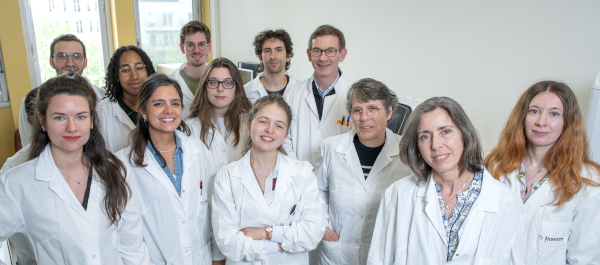
Team leader: Rozen Le Panse
Myasthenia gravis (MG) is an autoimmune disease caused by autoantibodies directed against components of the neuromuscular junction and leading to abnormal muscle fatigability. In most cases, the autoantibodies are directed against the acetylcholine receptor (AChR). However, in a minority of cases, patients have antibodies directed against other molecules of the muscle endplate, including the muscle specific tyrosine kinase (MuSK) or the lipoprotein-related protein 4 (LRP4).
The thymus is most likely the site of initiation of the disease in patients with anti- AChR antibodies. Indeed thymic histological abnormalities are very common in this subgroup of patients: 50-60 % of patients have a thymic follicular hyperplasia with germinal centers, 10 to 15% have a thymic tumor, and thymectomy is a beneficial treatment for many patients.
MG as all autoimmune diseases, is a multifactorial disease involving genetic and hormonal predisposing background, abnormalities of the immune system, and is triggered by unidentified factors. Among these, environmental factors such as viral infections or endocrine disrupters are highly suspected.
The team uses many immunological, cellular and molecular techniques, including omics approaches to identify factors that are responsible for the initiation of the disease, its development and its chronicity. The team is also developing new therapeutic approaches based on immune modulation.
Main projects
Our research aims to better understand the pathophysiological mechanisms in myasthenia gravis and to elucidate the events involved in the initiation and chronicity of the disease, with the long-term objective to propose new therapies. Our specific objectives are to:
- Identify the triggering mechanisms that cause myasthenia. We study the role of genetic factors and sex hormones, and analyze how the activation of signaling pathways of innate immunity may lead to remodeling of the thymus. We also analyze the relative contribution of the environment and the genetics, namely by exploring epigenetic data in monozygotic twins that are discordant for MG.
- Analyze the pathophysiological mechanisms in the thymus and in the muscle. In the thymus, we study how the cytokines related to IL-17 and T follicular cells affect immune regulation processes. In the muscle, we study the effects of pathogenic antibodies on muscle function, and the ability of satellite cells to regenerate muscle after the autoimmune attack.
- Provide a proof of concept of new immunotherapeutic approaches. To overcome the immune dysregulation defects observed in patients, we test the therapeutic potential of mesenchymal stem cells and molecules that interfere with the IL-17 inflammatory pathway. To this end, we developed a new pre-clinical experimental model based on an immune-deficient mice grafted with thymic biopsies from MG patients. This model recapitulates very well the clinical observations of MG patients, including clinical symptoms and anti-acetylcholine receptor antibody production.
- Search for biomarkers in the serum of MG patients. The finding of such molecules is very important for the follow up of the patients and the analysis of their response to various treatments. To do so, in collaboration with clinicians, we investigate circulating micro-RNAs and various cytokines.

Team members
Rozen Le Panse, DR1 CNRS, Team leader
Jean-Thomas Vilquin, DR2 CNRS
Nadine Dragin, Researcher AIM
Frédérique Truffault, Engineer AIM
Léa Lippens-Goethals, Engineer
Edouard Hemery, PhD student
Sofia Maria Sosa Marmol, PhD student
Ines Arnoux, PhD student
Maria Plan Gran, PhD student
Justine Hugon, Work-study student
Violaine Galland, Master student
Diana Koucem, Master student
Last publications
- M. Halliez, S. Cottin, A. You, C. Buon, A. Grondin, L. Lippens, M. Lemaitre, J. Ezan, C. Isch, Y. Ruffin, M. Montcouquiol, N. Sans, B. Fontaine, J. Messéant, R. Le Panse and L. Strochlic. MuSK cysteine-rich domain antibodies are pathogenic in a mouse model of autoimmune myasthenia gravis. Journal of Clinical Investigation, in press 2025.
- A. You, L.S. Lippens, OM. Fayet, S. Maillard, L. Betemps, A. Grondin, JT. Vilquin, N. Dragin, R. Le Panse. Development of a Refined Experimental Mouse Model of Myasthenia Gravis with Anti-Acetylcholine Receptor Antibodies. Frontiers in Immunology 2025, 16:1521382. DOI 10.3389/fimmu.2025.1521382
- L. Plomp, H. Chassepot, D. Psimaras, T. Maisonobe, E. Mensi, S. Leonard-Louis, I. Plu, A. Rozes, F. Tubach, M. Touat, C. Anquetil, N. Wesner, N. Champtiaux, A. Rigolet, S. Demeret, N. Weiss, M.-A. Alyanakian, R. Le Panse, F. Truffault, M.-A. Dragon-Durey, L. Chatenoud, B. Abbar, M.-C. Bretagne, A. Procureur, T. Similowski, C. Morelot, M. Dres, S. Ederhy, O. Benveniste, J.-E. Salem, Y. Allenbach. Features of myositis and myasthenia gravis in patients treated with immune checkpoint inhibitors: a multicentric, retrospective cohort study. The Lancet regional health – Europe 50: 101192, 2025. doi.org/10.1016/j.lanepe.2024.101192
- A. Mariscal, C. Martínez, L. Goethals, E. Cortés, E. Moltó, C. Juárez, B. Barneda, L. Querol, R. Le Panse, E. Gallardo. Comparison of different methods to quantify anti-acetylcholine receptor antibodies in a mouse model of myasthenia gravis. Journal of Immunological Methods 2024, 534 (113748). doi: 10.1016/j.jim.2024.113748
- F. Truffault, L. Auger, N. Dragin, J-T. Vilquin, E. Fadel, V. Thomas de Monpreville, A. Mansuet-Lupo, J-F. Regnard, M. Alifano, T. Sharshar, A. Behin, B. Eymard, F. Bolgert, S. Demeret, S. Berrih-Aknin and R. Le Panse. Comparison of Juvenile and Adult Myasthenia Gravis in a French Cohort with Focus on Thymic Histology. Scientific Report 2024, 4(1):13955. doi: 10.1038/s41598-024-63162-0.
- HJ. Kaminski, LL. Kusner, GC. Cutter, R. Le Panse, CD. Wright, Y. Perry, GI. Wolfe. Does Surgical Removal of the Thymus have Deleterious Consequences? Neurology 102: e209482, 2024. DOI:10.1212/WNL.0000000000209482.
- Book chapter: N. Dragin & R. Le Panse. Thymic Physiology and Pathophysiology in Myasthenia Gravis – Myasthenia Gravis 2025, Part A; Elsevier CCM-M-10586561.
- J. Verdier, O-M Fayet, E. Hemery, F. Truffault, N. Pinzón, S. Demeret, A. Behin, E. Fadel, J. Guihaire, A. Corneau, C. Blanc, S. Berrih-Aknin, R. Le Panse. Single-cell mass cytometry on peripheral cells in Myasthenia Gravis identifies dysregulation of innate immune cells. Front Immunol. 2023 Jan 30;14:1083218. doi: 10.3389/fimmu.2023.1083218. PMID: 36793723; PMCID: PMC9922723.
- J.A. Villegas, J. Van Wassenhove, J. Merrheim, K. Matta, S. Hamadache, C. Flaugère, P. Pothin, J. Mésséant, F. Truffault, S. Hascoët, N. Santelmo, M. Alifano, S. Berrih-Aknin, R. Le Panse, N. Dragin. Targeting IL-23 ameliorates thymic and neuromuscular defects in Myasthenia Gravis. J. Neuroinflammation 2023 Jan 13;20(1):9. doi: 10.1186/s12974-023-02691-3.
- C. Payet, A. You, O-M Fayet, E. Hemery, F. Truffault, V. Bondet, D. Duffy, F. Michel, E. Fadel, J. Guihaire, S. Demeret, S. Berrih Aknin, R. Le Panse. Central role of macrophages and nucleic acid release in Myasthenia Gravis thymus. Annals of Neurology 2022 Dec 26. doi: 10.1002/ana.26590.
- L. Almenara-Fuentes, S. Rodriguez-Fernandez, E. Rosell-Mases, K. Kachler, A. You, M. Salvado, D. Andreev, U. Steffen, H. Bang, A. Bozec, G. Schett, R. Le Panse, J. Verdaguer, M. Dalmases, S. Rodriguez-Vidal, B. Barneda-Zahonero, M. Vives-Pi. Inducing immune tolerance with liposomes encapsulating autoantigens. A platform for autoimmune diseases. J. Nanomedicine: Nanotechnology, Biology, Medicine. 2022, 5;48:102635. doi: 10.1016/j.nano.2022.102635.
- C. Payet, A. You, O. Fayet, N. Dragin, S. Berrih Aknin, R. Le Panse. Myasthenia Gravis: An acquired interferonopathy? Cells 11, 1218, 2022. DOI: doi.org/10.3390/cells11071218
- S. Thomas, O-M Fayet, F. Truffault, E. Fadel, B. Provost, A. Hamza, S. Berrih-Aknin, J-P. Bonnefont and R. Le Panse. Altered expression of Fragile X mental retardation-1 (FMR1) in the thymus in autoimmune Myasthenia Gravis. Journal of Neuroinflammation 18, 270, 2021. DOI: 10.1186/s12974-021-02311-y
- Berrih-Aknin S, Claeys KG, Law N, Mantegazza R, Murai H, Saccà F, Dewilde S, Janssen MF, Bagshaw E, Kousoulakou H, Larkin M, Beauchamp J, Leighton T, Paci S. Patient-reported impact of myasthenia gravis in the real world: protocol for a digital observational study (MyRealWorld MG). BMJ Open. 2021 Jul 20;11(7):e048198. DOI: 10.1136/bmjopen-2020-048198
- Birnbaum S, Porcher R, Portero P, Clair B, Demeret S, Eymard B, Gargiulo M, Louët E, Berrih-Aknin S, Le Panse R, Aegerter P, Hogrel JY, Sharshar T; MGEX Study Group. Home-based exercise in autoimmune myasthenia gravis: A randomized controlled trial. Neuromuscul Disord. 2021 Aug;31(8):726-735. doi: 10.1016/j.nmd.2021.05.002. Epub 2021 May 27. PMID: 34304969.

